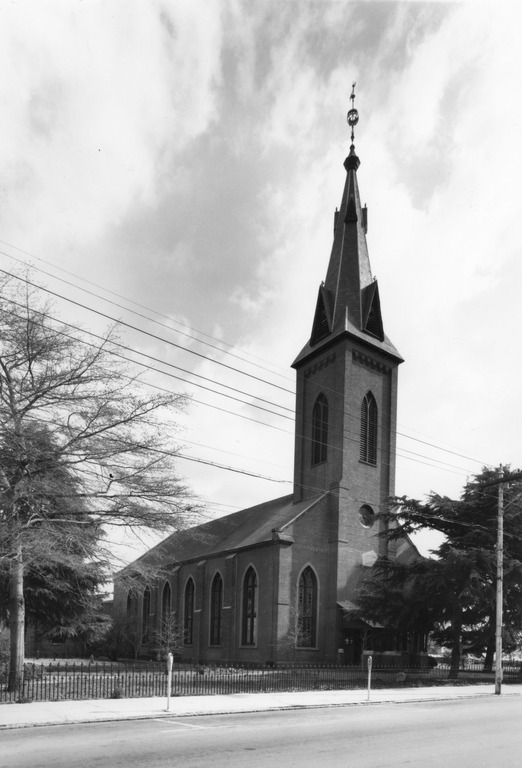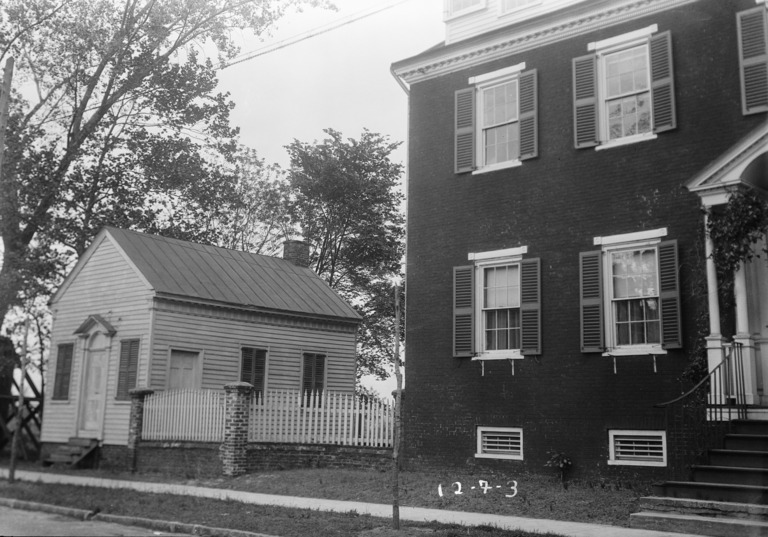Flanner, Bennett G. (1794-1868)
Birthplace:
North Carolina, USA
Residences:
- New Bern, North Carolina
Trades:
- Brickmason
NC Work Locations:
Building Types:
Styles & Forms:
Gothic Revival
Bennett G. Flanner (1794-1868) was a brickmason active in New Bern during the city’s Federal period heyday and known for his daring work at great heights. His parentage and early training are not yet documented. Like other men in the “trowel trades,” Flanner sometimes undertook plastering as well as brickwork: John Donnell’s account for construction of his fine brick townhouse (1816-1818) included several small payments to Bennett Flanner, “plasterer.”
Flanner was identified in the New Bern Carolina Centinel of July 14, 1821, as one of the two brickmasons who constructed the imposing, brick Christ Episcopal Church in 1821-1824. Along with Martin Stevenson and Thomas S. Gooding, who were identified as “architects” for the edifice, “master masons” Flanner and Wallace Moore marched in the procession to the laying of the cornerstone for the church in 1821. The brick church was constructed with the city’s favored Flemish bond brickwork and featured door and window openings in the pointed arched shape of the Gothic Revival mode then new to the city. Christ Church burned in 1871, destroying the upper stories and roof, and it was redesigned and rebuilt on the old walls; Flanner and Moore’s workmanship of the brick structure is all that remains of the original building.
In his memoir of New Bern in the early 1820s, Stephen Miller recalled the young Flanner with special vividness: “Bennett Flanner was among the leading men of his line, and completed the new Episcopal church edifice in 1824. He was bold, fearless, and persevering. He moved on the scaffolding high in the air, apparently with as much indifference as if standing on the pavement below. I saw him stand erect nearly a half hour on the apex of the steeple, not less than 150 feet high, with no other surface of support than the twenty or thirty inches diameter on which his feet rested.” In 1832, he was chosen along with other respected local builders (Hardy B. Lane, Sr., Joshua Mitchell, and Donum Montford) and other citizens to inspect and approve repairs to the church.
Like some other artisans, Bennett Flanner left his trade to seek his fortune in other enterprises. When he married Susan A. Green (1812-1890) on February 27, 1835, he was identified as a merchant in the New Bern Spectator. The couple remained in New Bern into the 1840s and had several children including Joseph, William, Caroline, Henry, Bennett, and Charles. Flanner owned town property including a lot on East Front Street, also known as the Clark property. He owned several slaves—seven in 1830 and ten in 1840—some of whom probably assisted him in his business. By 1850, Flanner left New Bern for the thriving port city of Wilmington, where he prospered in the naval stores business. In the United States Census of 1850, he was listed there as a manufacturer aged 56, owner of $10,000 in real estate and 22 slaves, many of whom probably worked in his naval stores operation. He was head of a household that included his wife, Susan, and their children. By 1860 he was identified as a commission merchant and owner of $25,000 in real estate and 21 slaves. He, Susan, and their two sons William and Henry were interred in Wilmington’s Oakdale Cemetery.
- Carolina Centinel, July 14, 1821.
- Gertrude S. Carraway, Crown of Life: History of Christ Church, New Bern, N. C., 1715-1940 (1940).
- John Donnell Letter Book and Account Book, Bryan Family Papers, Southern Historical Collection, Wilson Library, University of North Carolina at Chapel Hill, Chapel Hill, North Carolina.
- Lynda Vestal Herzog, “The Early Architecture of New Bern, 1750-1850,” Ph.D. dissertation, University of California (1977).
- Oakdale Cemetery gravestone information, courtesy of William Reaves.
- Peter B. Sandbeck, The Historic Architecture of New Bern and Craven County, North Carolina (1988).
Christ Episcopal Church
Contributors:George Bishop, contractor (1871-1885); Bennett Flanner, brickmason (1821-1824); Thomas S. Gooding, builder and architect (1821-1824); Hardy B. Lane, Sr., carpenter/joiner (1821-1824); Wallace Moore, brickmason (1821-1824); Martin Stevenson, builder and architect (1821-1824)Dates:1821-1824; 1871-1885 [rebuilt]
Location:New Bern, Craven CountyStreet Address:320 Pollock St., New Bern, NC
Status:Standing
Type:Religious
Images Published In:Catherine W. Bishir, North Carolina Architecture (1990).
Catherine W. Bishir and Michael T. Southern, A Guide to the Historic Architecture of Eastern North Carolina (1996).
Peter B. Sandbeck, The Historic Architecture of New Bern and Craven County, North Carolina (1988).Note:Christ Episcopal Church in New Bern, built in 1821-1824, was one of the first Gothic Revival churches in North Carolina. Although the local newspaper cited Martin Stevenson and Thomas S. Gooding, local artisans, as “architects,” in 1820 the parish already had a plan for a church to be 70 by 55 feet, of brick, and with “high arched windows” before letting the contract. It was built of Flemish bond brickwork with pointed arched windows and a blending of Gothic Revival, Federal, and Greek Revival details. It is tempting to attribute some role in design to architect William Nichols, who had been in New Bern earlier, but there is no documentation of his role. Only the walls of this first period survive: after a fire in 1871 the church was rebuilt by George Bishop using the old walls. The image here shows the church after it was rebuilt following the fire. See Sandbeck, New Bern, and Bishir, North Carolina Architecture, for drawings of the 1820s church before the fire.
John R. Donnell House
Contributors:William Charlotte, painter; Bennett Flanner, plasterer; Asa King, carpenter; Joshua Mitchell, brickmason; Donum Montford, brickmaker; Wallace Moore, brickmason; Peter Shepherd, brickmasonDates:1816-1818
Location:New Bern, Craven CountyStreet Address:Craven St., New Bern, NC
Status:No longer standing
Type:Residential
Images Published In:Frances Benjamin Johnston and Thomas Tileston Waterman, The Early Architecture of North Carolina (1941).
Peter B. Sandbeck, The Historic Architecture of New Bern and Craven County, North Carolina (1988).Note:Through the records kept by John R. Donnell, known as “Judge Donnell,” the construction history documentation for this house is unusually complete. (See John Donnell Letter Book and Account Book, Bryan Family Papers, Southern Historical Collection, University of North Carolina, Chapel Hill, North Carolina.) One of New Bern’s finest Federal style buildings, it was a 2-story house of brick laid in Flemish bond and followed a side-passage plan. It featured an unusually early local example of bullseye cornerblocks flanking the window lintels. The house was destroyed by fire in 1972. The adjoining office was moved to a suburban site, and some elements of the elegant woodwork were also salvaged. Because this house was similar to other Federal period houses in town, as discussed in Peter B. Sandbeck, The Historic Architecture of New Bern and Craven County, North Carolina (1988), Donnell’s records provide clues to the artisans involved in other buildings.


